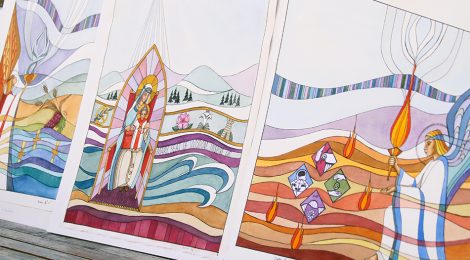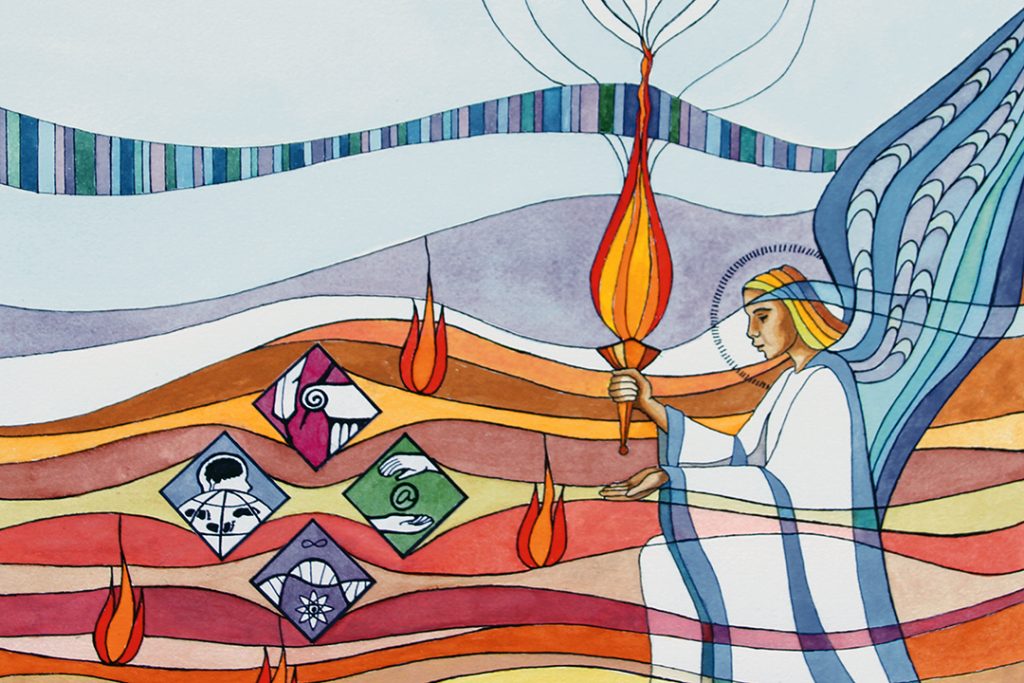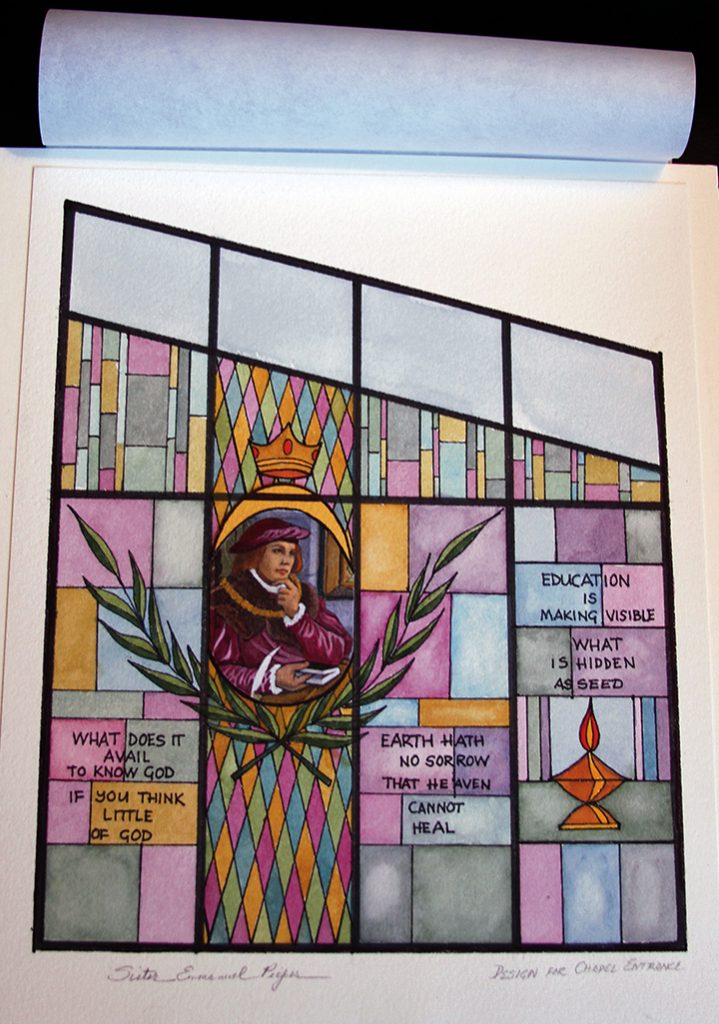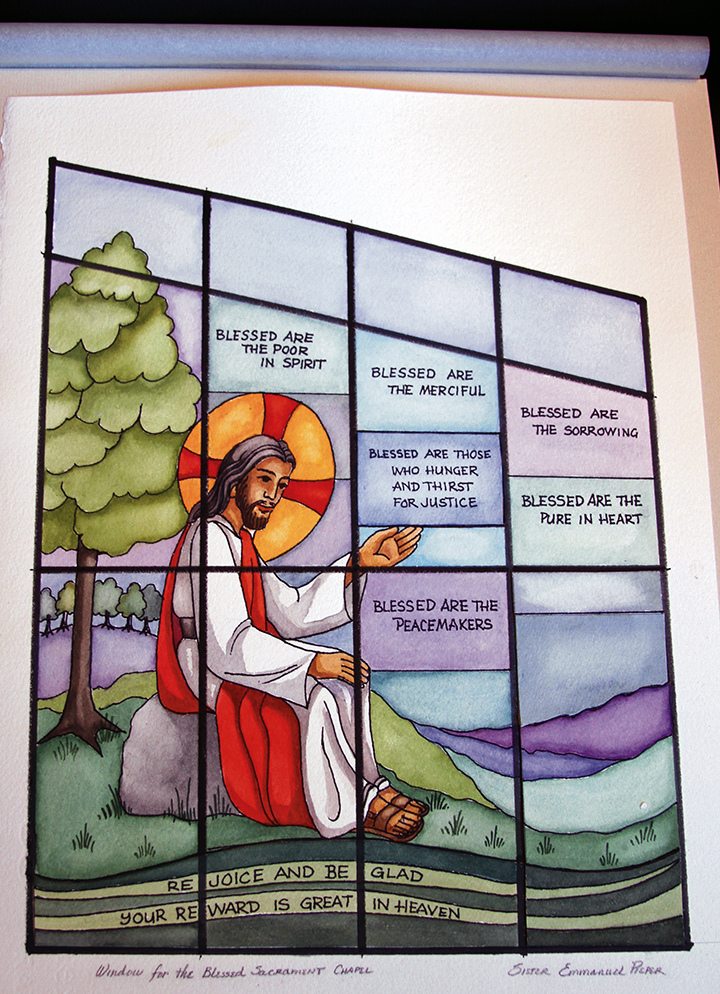
Enlightenment – the stained glass in Mary, Seat of Wisdom Chapel
Measuring as high as 35 feet, the stained glass windows are a true focal point of Mary, Seat of Wisdom Chapel.
Written by Stacy Smith Rogers to commemorate the establishment of Mary, Seat of Wisdom Chapel in 2012

Sr. Emmanuel Pieper, St. Walburg Monastery, designed the stained glass windows in the chapel. She worked closely with stained glass artist David Duff, Classical Glass, to bring her designs to life.
Sr. Emmanuel is a freelance artist and is regularly commissioned by individuals and businesses for her artwork. She holds a master’s degree in fine arts from the University of Notre Dame and previously taught art at Villa Madonna Academy for 41 years. Her work, including oils, acrylics, watercolors, banners and stained glass window designs, graces St. Elizabeth Healthcare Hospice, St. Patrick and St. Barbara parishes, and Thomas More College, as well as St. Walburg Monastery. She entered St. Walburg Monastery in 1945 and made her perpetual profession in 1950. In addition to her beautiful artwork, Sr. Emmanuel loves to garden, make quilts, design greeting cards and to create books that document community history. She loves history and working on projects that will preserve it and said she hasn’t met an art form she didn’t like.
“I love projects like this. When I’m working on something, if I have a view of it in my mind, it’s usually too grandiose. Eventually, it turns out to be a little closer to earth,” she said. Sr. Emmanuel described the experience of watching her small scale drawings become larger than life. “I’ve seen a lot of the parts, going to David’s studio. And, they all look good in pieces. But you have to get them all together to get a full view. David was very nice to work with and so accommodating in all ways. I’m very glad to have him a part of this project. When you do something like this you know it’s going to be there for a long, long time. You don’t want to make any mistakes, and you want to be very careful in choice in everything.”
David Duff has been creating architectural art glass for Classical Glass in Cincinnati since 1974. He has studied under renowned glass masters Roger Darricarier in Chartes, France and Narcissus Quagualata in Mexico City. David has executed commissions for private collections in Paris, France, Amman, Jordan and Seoul, Korea, and his work can also be seen in numerous locations in Greater Cincinnati. When he was first commissioned for the project, his work space was not large enough to accommodate the scale of these windows. He moved to another location that allowed his team to handle the project. David elaborated on the experience, “I am thankful for the trust and vision Sister Margaret and Sister Emmanuel had in my ability to execute this project and am grateful to have been chosen to transform Sister Emmanuel’s art into stained glass. Her magnificent art has translated beautifully into a stained glass wall that will inspire all who see it.”
Description of the windows:

The Christian Life – This window is dominated by an angel with a large brazier of incense. In the Christian faith, incense is offered to God alone. Through the lower part of the window, flow the waters of baptism interspersed with the sign of the cross, symbols that establish our Christian dedication. In the Eucharist, symbolized by the grapes and wheat, the Christ-life begun at baptism is sustained in us and made fruitful in the Church and the world.

Mary, Seat of Wisdom – Mary as Seat of Wisdom is the chosen patroness for this chapel. In this titular window, Mary with her Divine Son, the source of wisdom, sits ready to dispense that grace to those who sincerely ask it of her. Other symbols from the Litany of the Blessed Virgin adorn the window: Star of the Sea of Life, Queen of Peace, Mystical Rose and Tower of Ivory.

Academic Learning – In this window, an angel holds aloft the flame of learning, the essence of the existence of this college, the reason for the dedication of its teaching staff and the hope of students in attendance here. The diamond-shaped symbols represent the major components of a liberal arts education — humanities, natural sciences, social sciences and the professions.

Saint Thomas More – Here, the youthful Thomas More sits engrossed in his studies. It was his dedication to the search for truth, goodness and justice that colored his future life as chancellor of England under Henry VIII and eventually led to martyrdom for his principles. The symbols of that martyrdom, the palms and the crown, are above and below the image of Thomas More with quotes from his writings in other parts of the window.

Sermon on the Mount – With his usual pointed rhetoric, Jesus gives us directions for a good life, a life of blessing, a life that will advance the purpose of this good earth and all God’s people. This meditation chapel places these beatitudes before the eyes and spirits of all who pray here in the hope that these blessings will be carried through their lives far beyond these college years.

Sanctuary – Flames – Flames of fire have symbolized many things in the history of the arts: love, wisdom, learning, creativity and in the New Testament, the gifts of the Spirit. In the window above the altar, the series of flames invites the viewer to meditate on this symbol in his or her personal life: the flame of love, deep and true, the flame of learning, in life-changing light, and the flame of the Spirit enhancing the God-life in the soul. The symbol of flame speaks to all of us in varied ways.
Hall panels reflect the early days of the college. In 1921, it was initiated as a teachers’ college by the Benedictine Sisters. Very soon thereafter the Sisters of Divine Providence and the Sisters of Notre Dame joined in the effort and added to the teaching staff, making it a three-community sponsorship. The panels contain the symbols by which these communities are recognized today.

Comments are closed, but trackbacks and pingbacks are open.